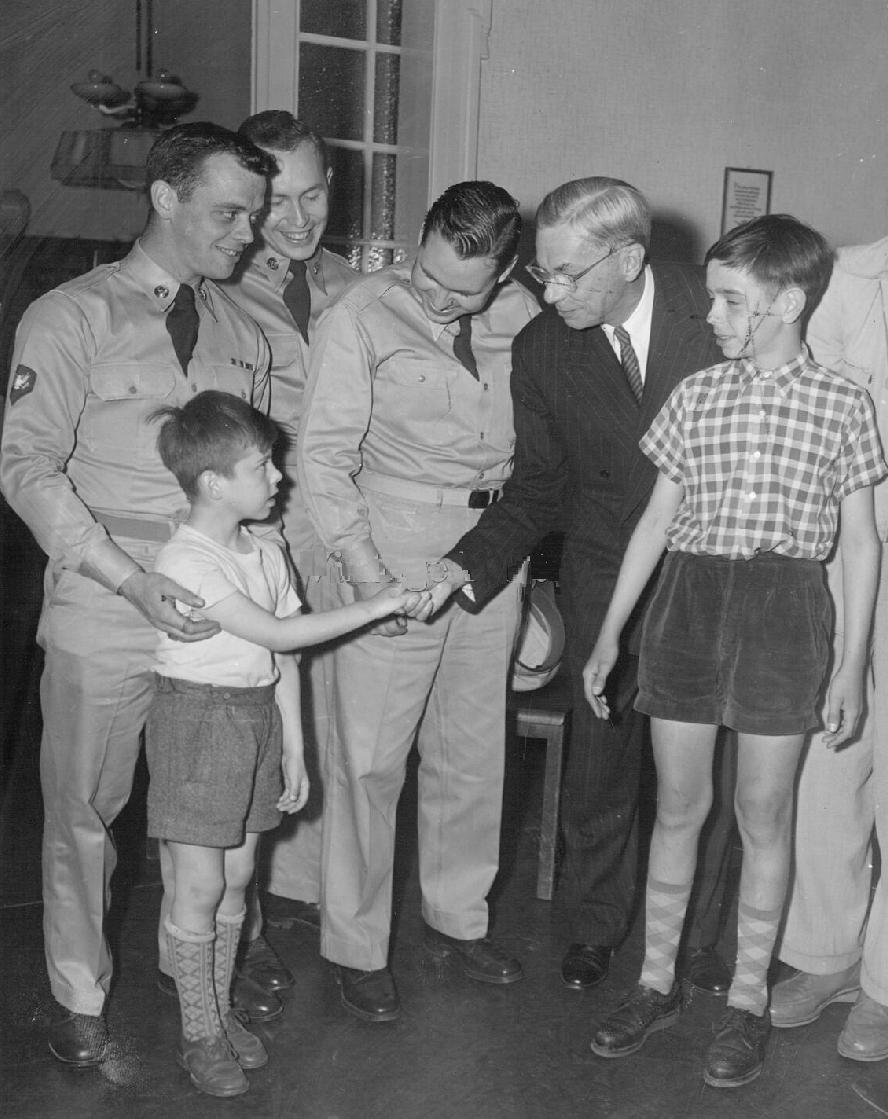
German Orphanages: Chronology--20th Century

Figure 1.--Here American soldiers occupying in 1956 Germany are posed with children at an orphnnage that they are helping to support. The presscaption read, "Speciaslist Wesley G Hohlbein is a member ofthe 287th Military Police Company in West Berlin, which recently collected money foir a German children's home. Holbein, son of Wesley A. Holbein, 16226 12th Ave N.E.hasbeen in Germany 18 months. Heis due home in September of 1957."
|
|
We see Kaiser Wilhelm visiting an orphanage named after him in Ahlbeck before World War I on the previous page. The two world war created a need for institutions caring for children. In connection with World War I, one often thinks of Belgian and French orphanages. The last years of the War and the years immediately following World War I were terribly difficult in Germany. Large numbers of German civilians experienced hunger and malnutrition. Some even died of died of starvation, but we are not sure how many. (This was one factor in undermining civilian morale in World War I and a reason that the NAZIs attempted to avoid rationing in the early years of World War II, efforts which led to the plundering of occupied countries.) Unlike World War I efforts to feed Belgium, because of the War there was little interest in humanitarian assistance to Germany, even after the War. Many fathers were killed in the War and mothers had trouble feeding their children. Unemployment was rife and fathers that did return could not find jobs. Thus large numbers of children were put in orphanages at least temporarily because their parents could not feed them. One boy who spent 1916-18 in an orphanage with his brother recalls the meager food. His family was not allowed to supplement the food or even give a few coins. Such donations had to be turned over to the orphanage. He did not mention the clothing at the orphanage. After World War I, the difficult economic conditions probably caused more parents, especially single-parent families to put children in orphanages. After seizing power, the NAZIs began to take over charity institutions, primarily by restricting find raising by religious groups. The NAZI welfare organization was the Nationalsozialistische Volkswohlfahrt/People's Welfare Organization (NSV). We do not have any details yet on orphanages administered by the NSV. After the War, the NSV along with all NAZI organizations were dissolved. Religious groups were able to resume their charity roles. And some orphanages were opened for the many children needing care. The NAZI assault on the churches, however, permanently damaged both the churches and their ability to support charity institutions. The state began to play a larger role. This was especially true in the Soviet zone (Eastern Germany) where the regime began an atheist campaign. Soviets authorities in former East Prussia put German orphans (often called Wolf children) in orphanages overseen by Soviet military officers but staffed mostly with Germans still remaining in East Prussia. The Soviets reported 4,700 German orphans in Kaliningrad (1947). They deported several train loads of German orphans to the DDR. Some of the trains took 4-7 days to get to the DDR. The children in many cases were not provided with food or toilet facilities. Some died. The number is unknown. The DDR opened the Kinderdorf Kyritz, children's village of Pinnow (1948). [Leiserowitz] We continue to see orphans in the post-War era, young childen who were orphaned after the War. We notice Save the Children helping to find orphans homes in Sweden. We also see children at the orphanages that were probably born just after the War. Some of the children were probably the result of rampant Red Army rapeing when they reached Germany in 1944-45. These were children either the mothers did not want or could not care for by themselves. Or if the husbands survived the War they did not want the child. We have not found information addressing this question in detail. We note some womem committed suiside. Some had abortions although we are not sure how availvle this option was.
Sources
Leiserowitz, Ruth. Von Ostpreußen nach Kyritz. Wolfskinder auf dem Weg nach Brandenburg (From East Prussia to Kyritz. Wolf children on their way to Brandenburg) (Brandenburgische Zentrale für politische Bildung: Potsdam, 2003),
HBC

Navigate the Historic Boys' Clothing Web Site:
[Return to the Main German orphanage chronology page]
[Return to the Main German orphanage page]
[Return to the Main orphanage country page]
[Return to the Main institutional page]
[Return to the Main German institutional page]
[Introduction]
[Activities]
[Biographies]
[Chronology]
[Clothing styles]
[Countries]
[Bibliographies]
[Contributions]
[FAQs]
[Glossaries]
[Images]
[Links]
[Registration]
[Tools]
[Boys' Clothing Home]
Created: 12:58 PM 2/4/2019
Last updated: 12:58 PM 2/4/2019



